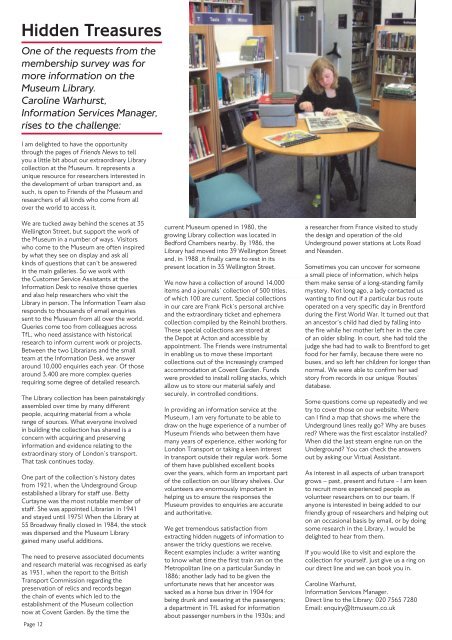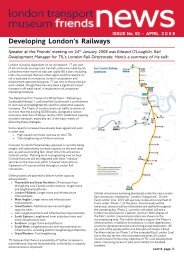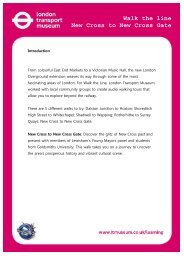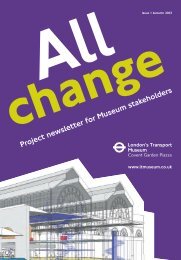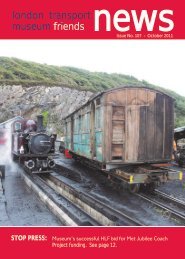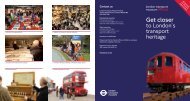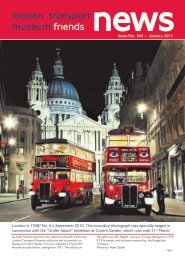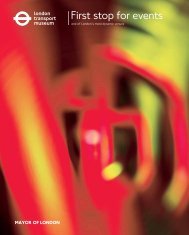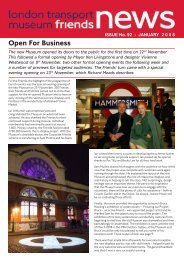london transport museum friends news
london transport museum friends news
london transport museum friends news
You also want an ePaper? Increase the reach of your titles
YUMPU automatically turns print PDFs into web optimized ePapers that Google loves.
Hidden Treasures<br />
One of the requests from the<br />
membership survey was for<br />
more information on the<br />
Museum Library.<br />
Caroline Warhurst,<br />
Information Services Manager,<br />
rises to the challenge:<br />
I am delighted to have the opportunity<br />
through the pages of Friends News to tell<br />
you a little bit about our extraordinary Library<br />
collection at the Museum. It represents a<br />
unique resource for researchers interested in<br />
the development of urban <strong>transport</strong> and, as<br />
such, is open to Friends of the Museum and<br />
researchers of all kinds who come from all<br />
over the world to access it.<br />
We are tucked away behind the scenes at 35<br />
Wellington Street, but support the work of<br />
the Museum in a number of ways. Visitors<br />
who come to the Museum are often inspired<br />
by what they see on display and ask all<br />
<br />
in the main galleries. So we work with<br />
the Customer Service Assistants at the<br />
Information Desk to resolve those queries<br />
and also help researchers who visit the<br />
Library in person. The Information Team also<br />
responds to thousands of email enquiries<br />
sent to the Museum from all over the world.<br />
Queries come too from colleagues across<br />
TfL, who need assistance with historical<br />
research to inform current work or projects.<br />
Between the two Librarians and the small<br />
team at the Information Desk, we answer<br />
around 10,000 enquiries each year. Of those<br />
around 3,400 are more complex queries<br />
requiring some degree of detailed research.<br />
The Library collection has been painstakingly<br />
assembled over time by many different<br />
people, acquiring material from a whole<br />
range of sources. What everyone involved<br />
in building the collection has shared is a<br />
concern with acquiring and preserving<br />
information and evidence relating to the<br />
<br />
That task continues today.<br />
<br />
from 1921, when the Underground Group<br />
established a library for staff use. Betty<br />
Curtayne was the most notable member of<br />
staff. She was appointed Librarian in 1941<br />
and stayed until 1975! When the Library at<br />
55 Broadway finally closed in 1984, the stock<br />
was dispersed and the Museum Library<br />
gained many useful additions.<br />
The need to preserve associated documents<br />
and research material was recognised as early<br />
as 1951, when the report to the British<br />
Transport Commission regarding the<br />
preservation of relics and records began<br />
the chain of events which led to the<br />
establishment of the Museum collection<br />
now at Covent Garden. By the time the<br />
Page 12<br />
current Museum opened in 1980, the<br />
growing Library collection was located in<br />
Bedford Chambers nearby. By 1986, the<br />
Library had moved into 39 Wellington Street<br />
and, in 1988 ,it finally came to rest in its<br />
present location in 35 Wellington Street.<br />
We now have a collection of around 14,000<br />
<br />
of which 100 are current. Special collections<br />
<br />
and the extraordinary ticket and ephemera<br />
collection compiled by the Reinohl brothers.<br />
These special collections are stored at<br />
the Depot at Acton and accessible by<br />
appointment. The Friends were instrumental<br />
in enabling us to move these important<br />
collections out of the increasingly cramped<br />
accommodation at Covent Garden. Funds<br />
were provided to install rolling stacks, which<br />
allow us to store our material safely and<br />
securely, in controlled conditions.<br />
In providing an information service at the<br />
Museum, I am very fortunate to be able to<br />
draw on the huge experience of a number of<br />
Museum Friends who between them have<br />
many years of experience, either working for<br />
London Transport or taking a keen interest<br />
in <strong>transport</strong> outside their regular work. Some<br />
of them have published excellent books<br />
over the years, which form an important part<br />
of the collection on our library shelves. Our<br />
volunteers are enormously important in<br />
helping us to ensure the responses the<br />
Museum provides to enquiries are accurate<br />
and authoritative.<br />
We get tremendous satisfaction from<br />
extracting hidden nuggets of information to<br />
answer the tricky questions we receive.<br />
Recent examples include: a writer wanting<br />
to know what time the first train ran on the<br />
Metropolitan line on a particular Sunday in<br />
1886; another lady had to be given the<br />
unfortunate <strong>news</strong> that her ancestor was<br />
sacked as a horse bus driver in 1904 for<br />
being drunk and swearing at the passengers;<br />
a department in TfL asked for information<br />
about passenger numbers in the 1930s; and<br />
a researcher from France visited to study<br />
the design and operation of the old<br />
Underground power stations at Lots Road<br />
and Neasden.<br />
Sometimes you can uncover for someone<br />
a small piece of information, which helps<br />
them make sense of a long-standing family<br />
mystery. Not long ago, a lady contacted us<br />
wanting to find out if a particular bus route<br />
operated on a very specific day in Brentford<br />
during the First World War. It turned out that<br />
<br />
the fire while her mother left her in the care<br />
of an older sibling. In court, she had told the<br />
judge she had had to walk to Brentford to get<br />
food for her family, because there were no<br />
buses, and so left her children for longer than<br />
normal. We were able to confirm her sad<br />
<br />
database.<br />
Some questions come up repeatedly and we<br />
try to cover those on our website. Where<br />
can I find a map that shows me where the<br />
Underground lines really go Why are buses<br />
red Where was the first escalator installed<br />
When did the last steam engine run on the<br />
Underground You can check the answers<br />
out by asking our Virtual Assistant.<br />
As interest in all aspects of urban <strong>transport</strong><br />
grows past, present and future - I am keen<br />
to recruit more experienced people as<br />
volunteer researchers on to our team. If<br />
anyone is interested in being added to our<br />
friendly group of researchers and helping out<br />
on an occasional basis by email, or by doing<br />
some research in the Library, I would be<br />
delighted to hear from them.<br />
If you would like to visit and explore the<br />
collection for yourself, just give us a ring on<br />
our direct line and we can book you in.<br />
Caroline Warhurst,<br />
Information Services Manager.<br />
Direct line to the Library: 020 7565 7280<br />
Email: enquiry@lt<strong>museum</strong>.co.uk


